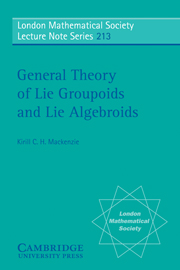Book contents
- Frontmatter
- Contents
- Prologue
- Introduction
- Preface
- TERMINOLOGY AND NOTATION
- ACKNOWLEDGEMENTS
- PART ONE THE GENERAL THEORY
- PART TWO THE TRANSITIVE THEORY
- 5 Infinitesimal Connection Theory
- 6 Path Connections and Lie Theory
- 7 Cohomology and Schouten Calculus
- 8 The Cohomological Obstruction
- PART THREE THE POISSON AND SYMPLECTIC THEORIES
- Appendix
- Bibliography
- Index
7 - Cohomology and Schouten Calculus
from PART TWO - THE TRANSITIVE THEORY
Published online by Cambridge University Press: 05 April 2013
- Frontmatter
- Contents
- Prologue
- Introduction
- Preface
- TERMINOLOGY AND NOTATION
- ACKNOWLEDGEMENTS
- PART ONE THE GENERAL THEORY
- PART TWO THE TRANSITIVE THEORY
- 5 Infinitesimal Connection Theory
- 6 Path Connections and Lie Theory
- 7 Cohomology and Schouten Calculus
- 8 The Cohomological Obstruction
- PART THREE THE POISSON AND SYMPLECTIC THEORIES
- Appendix
- Bibliography
- Index
Summary
Despite its presence in Part II, most of the material in this chapter is valid for arbitrary Lie algebroids.
§7.1 constructs the cohomology of an arbitrary Lie algebroid with coefficients in an arbitrary representation and gives interpretations in degrees 2, 1 and 0. We use the most straightforward definition, in terms of a standard resolution of de Rham, or Chevalley–Eilenberg, type. This definition, as well as being the simplest, is the closest to the geometric applications. In 7.1.5 and 7.1.6 we prove that when A is a transitive Lie algebroid with adjoint bundle L, the cohomology spaces ℋ•(L, ρ+, E) are the modules of sections of certain flat vector bundles ℋ•(L, ρ+, E). This is a generalization to all degrees of 6.5.13 and is proved using a generalization of the calculus of differential forms on a manifold, and other results of Chapter 6. In 7.1.7 and 7.1.8 we calculate ℋ•(AΩ, ρ, E) for a locally trivial Lie groupoid Ω and any representation ρ of AΩ, in terms of the equivariant de Rham cohomology of an associated principal bundle.
In the second part of §7.1 we interpret ℋ2(A, ρ, E) in terms of equivalence classes of operator extensions of A by E. This is a straightforward generalization of the corresponding extension theory of Lie algebras, but we have given at least sketch proofs of most results, since there is no readily available account of the Lie algebra theory in the detail which is required for the geometric applications here.
- Type
- Chapter
- Information
- General Theory of Lie Groupoids and Lie Algebroids , pp. 257 - 310Publisher: Cambridge University PressPrint publication year: 2005

